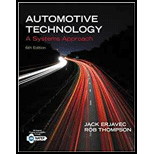
Automotive Technology (Custom)
6th Edition
ISBN: 9781337495356
Author: ERJAVEC
Publisher: Cengage
expand_more
expand_more
format_list_bulleted
Textbook Question
Chapter 36, Problem 11RQ
Which of the following CANNOT be used as a source for the production of hydrogen?
a. Gasoline
b. Methanol
c. Carbon dioxide
d. Natural gas
Expert Solution & Answer
Trending nowThis is a popular solution!

Students have asked these similar questions
109. Suit formation in diesel engine is due to
1) excess fuel during combustion
2) excess air during combustion
3) excess carbon during combustion
4) excess CO during combustion
Part A
Some tire stores claim that filling your car tires with pure, dry nitrogen is much better than using plain air. They make the following claims.
1. The pressure inside N₂-filled tires does not rise or fall with temperature changes.
2. Nitrogen leaks out of tires much more slowly than air because the N₂ molecules are bigger.
3. Nitrogen is not very reactive, and moisture and O₂ in air cause corrosion that shortens tire life by 25-30%
Evaluate the claim as a whole.
Check all that apply.
Claim passes falsifiability test.
Claim passes logic test.
Claim passes replicability test.
Claim passes sufficiency test
Claim fails all four FLaReS tests.
Submit
Request Answer
Methyl alcohol (CH₂OH) burns in dry air according to the reaction
CH₂OH +3.3(0₂ +3.76N₂)→ CO₂ + 2H₂O +1.80₂ + 12.408N₂
Determine the
a. air-fuel ratio on a mass basis.
b. equivalence ratio.
c. percent excess air.
Chapter 36 Solutions
Automotive Technology (Custom)
Ch. 36 - Why are carbon dioxide emissions a concern?Ch. 36 - List five things a driver of a BEV can do to...Ch. 36 - What makes up the propulsion system in a BEV?Ch. 36 - What basic factors affect the required time to...Ch. 36 - There are two basic ways a BEV is connected to an...Ch. 36 - Explain what the ratings of kilowatts and kilowatt...Ch. 36 - True or False? All fuel cell vehicles have...Ch. 36 - Which of the statements about hydrogen is true? a....Ch. 36 - True or False? A PEM fuel cell needs to operate at...Ch. 36 - Why is water control so important to the...
Ch. 36 - Which of the following CANNOT be used as a source...Ch. 36 - Which of the following statements about fuel cells...Ch. 36 - What is the basic fuel for a fuel cell? a....Ch. 36 - The component that changes the molecular structure...Ch. 36 - Which of the following statements about hydrogen...Ch. 36 - Technician A says power is the ability to do work....Ch. 36 - While discussing inductive charging: Technician A...Ch. 36 - Technician A says some BEVs use liquid to heat the...Ch. 36 - While discussing charger connections: Technician A...Ch. 36 - Technician A says that a fuel cell produces...Ch. 36 - While diagnosing the control system of a BEV:...Ch. 36 - Prob. 7ASRQCh. 36 - Technician A says that all FCEVs have regenerative...Ch. 36 - Technician A says that gasoline can be used as a...Ch. 36 - While discussing hydrogen: Technician A says that...
Knowledge Booster
Learn more about
Need a deep-dive on the concept behind this application? Look no further. Learn more about this topic, mechanical-engineering and related others by exploring similar questions and additional content below.Similar questions
- A GEO spacecraft holds 700 kg of oxidizer. If the density of nitrogen tetroxide is 1440 kg/m^3 and the mixture ratio of the bi-prop system is 1.323, _____ m^3 volume is needed to store the oxidizer, and there is ______ kg of hydrazine fuel.arrow_forwardA fuel has the following constituents: carbon 85%, hyrdogen 13%, oxygen 2%. When burning this fuel in a boiler furnace the air supply is 50% in excess. Calculate the actual air-fuel ratio.arrow_forward3.3 the percentage analysis, by volume, of the exhaust gases for complete combustion.arrow_forward
- 11.Which of the following can be used as fuel in compressed form? a. Petrol b. Natural Gas c. Coal d. Uraniumarrow_forwardWhen a hydrocarbon fuel is burned, almost all of the carbon in the fuel burns completely to form CO2 (carbon dioxide), which is the principal gas causing the greenhouse effect and thus global climate change.arrow_forwardWhat is the average efficiency of internal combustion? (Indicate the types of internal combustion engine and corresponding efficiency.)arrow_forward
- 30° 30° B H. b 2barrow_forwardExplain the Ideal and perfect gas - basic conceptsarrow_forwardProblems 1. On burning 0.72 g of a solid fuel in a Bomb calorimeter, the temperature of 250 g of water is increased from 27.3°C to 29.1°C. If the water equivalent is 150 g, calculate the HCV of the fuel. 2. Calculate the minimum amount of air required for the complete combustion of 150 kgs of fuel containing 70 % Carbon, 15 % hydrogen, 5 % sulfur and the rest nitrogen by weight.arrow_forward
- QUESTION 7 (Fuels and Combustion) (a) The volumetric analysis of the flue gases from a boiler consists of CO2 = 10.9%, co = 1%, O2 = 7.1% and N2 = 81.0%. Determine the mass of the flue gas per kg of burnt fuel. (b) The mass analysis of a flue gas is: CO2 = 21.6%, CO = 2.2%, O2 = 1.7% and N2 = 74.5%. Determine the mass of the flue gas per kg of burnt fuel.arrow_forward1. A bituminous coal has the following composition as follows: C=71.5%, O=6%, S-4.6% W=3.4% H=5% N=1.3% Ash=3.2% Compute the amount of nitrogen produced during combustion process in lb/lb-coal. Also, determine the stoichiometric amount of air present in the combustion.arrow_forwardWhat would be the likely steps needed to be taken to plan the research, funding, and installation of Hydrogen car Chargers in a big city?arrow_forward
arrow_back_ios
SEE MORE QUESTIONS
arrow_forward_ios
Recommended textbooks for you
 Refrigeration and Air Conditioning Technology (Mi...Mechanical EngineeringISBN:9781305578296Author:John Tomczyk, Eugene Silberstein, Bill Whitman, Bill JohnsonPublisher:Cengage Learning
Refrigeration and Air Conditioning Technology (Mi...Mechanical EngineeringISBN:9781305578296Author:John Tomczyk, Eugene Silberstein, Bill Whitman, Bill JohnsonPublisher:Cengage Learning

Refrigeration and Air Conditioning Technology (Mi...
Mechanical Engineering
ISBN:9781305578296
Author:John Tomczyk, Eugene Silberstein, Bill Whitman, Bill Johnson
Publisher:Cengage Learning
Extent of Reaction; Author: LearnChemE;https://www.youtube.com/watch?v=__stMf3OLP4;License: Standard Youtube License